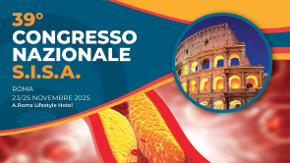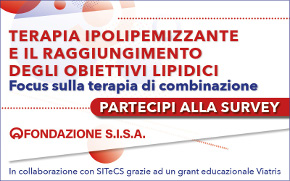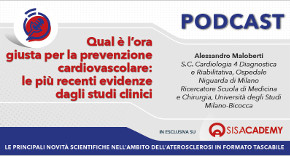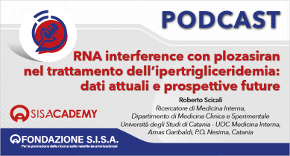 Rivista in lingua italiana
Rivista in lingua italiana
riservata ai Soci SISA
Ultimo numero:
Anno 16 • N.1/2025
Abstract
Extreme lipoprotein(a) levels and improved cardiovascular risk prediction.
Kamstrup PR, Tybjærg-Hansen A, Nordestgaard BG
J Am Coll Cardiol 2013;61:1146-56
OBJECTIVES: The study tested whether extreme lipoprotein(a) levels and/or corresponding LPA risk genotypes improve myocardial infarction (MI) and coronary heart disease (CHD) risk prediction beyond conventional risk factors.
BACKGROUND: Elevated lipoprotein(a) levels cause MI and CHD. Levels are primarily determined by variation in the LPA gene.
METHODS: We followed 8,720 Danish participants in a general population study from 1991 to 1994 through 2011 without losses to follow-up. During this period, 730 and 1,683 first-time MI and CHD events occurred. Using predefined cutpoints for extreme lipoprotein(a) levels and/or corresponding LPA risk genotypes (kringle IV type 2 [KIV-2]) repeat polymorphism, rs3798220, and rs10455872 single nucleotide polymorphisms), we calculated net reclassification indices from <10% to 10% to 19.9% to =20% absolute 10-year MI and CHD risk.
RESULTS: For individuals with lipoprotein(a) levels =80th percentile (=47 mg/dl), 23% (p < 0.001) of MI events and 12% (p < 0.001) of CHD events were reclassified correctly, while no events were reclassified incorrectly for either endpoint. As some incorrect reclassification of individuals with no events occurred, addition of lipoprotein(a) levels =80th percentile overall yielded net reclassification indices of +16% (95% confidence interval: 8% to 24%) and +3% (-1% to 8%) for MI and CHD, respectively. Corresponding net reclassification indices for number of KIV-2 repeats =21st percentile were +12% (5% to 19%) and +4% (0% to 8%), for rs3798220 carrier status +15% (-14% to 44%) and +10% (-10% to 30%), and for rs10455872 carrier status +16% (6% to 26%) and +2% (-1% to 6%). Considering only individuals at 10% to 19.9% absolute 10-year MI and CHD risk, addition of extreme lipoprotein(a) levels or corresponding LPA risk genotypes improved risk prediction even further.
CONCLUSIONS: Extreme lipoprotein(a) levels or corresponding LPA KIV-2/rs10455872 risk genotypes substantially improved MI and CHD risk prediction.
J Am Coll Cardiol 2013;61:1146-56

Area Soci
Eventi
39° Congresso Nazionale
 39° Congresso Nazionale
39° Congresso NazionaleRoma, 23-25 novembre 2025
Save the date




 Spring Meeting Gruppi Giovani SID, SIGG, SIIA, SIMI, SIPREC, SISA
Spring Meeting Gruppi Giovani SID, SIGG, SIIA, SIMI, SIPREC, SISARimini, 6-8 aprile 2025
[continua a leggere]
 SISA LIPID ACADEMY - Corso avanzato di lipidologia clinica
SISA LIPID ACADEMY - Corso avanzato di lipidologia clinicaModena, 4-5 Luglio 2024
[continua a leggere]Giornale Italiano Arteriosclerosi
HoFH today
 Rivista Italiana della
Rivista Italiana della
Ipercolesterolemia
Familiare Omozigote
Anno 6 • N.1/2024
Rivista NMCD
Diateca
[continua a leggere]
[continua a leggere]
Newsletter
il vostro indirizzo di posta elettronica
Progetto LIPIGEN

Nuovo sito dedicato al Progetto LIPIGEN
Progetto LIPIGEN - Vecchio portale
E' necessario essere loggati come utente
Lipigen per poter accedere alla pagina
PROject Statin Intolerance SISA
PROSISA – PROject Statin Intolerance SISA
E' necessario essere loggati come utente
PROSISA per poter accedere alla pagina
GILA - Lipoprotein Aferesi
Gruppo Interdisciplinare Lipoprotein Aferesi
(Accesso Gruppo GILA-Lipoprotein Aferesi)
E' necessario essere loggati come utente del Gruppo GILA per poter accedere
Gruppo Interdisciplinare Lipoprotein Aferesi
(Documentazione ad accesso libero)
Pagina informativa per medici e pazienti










